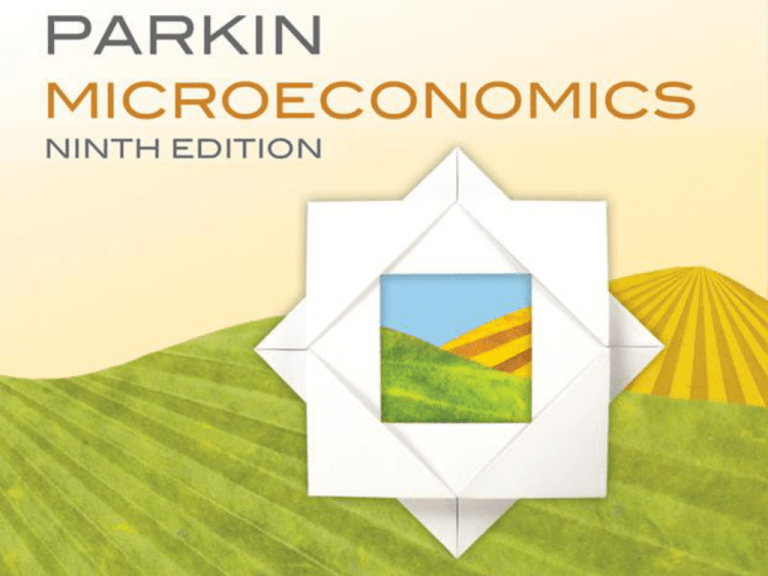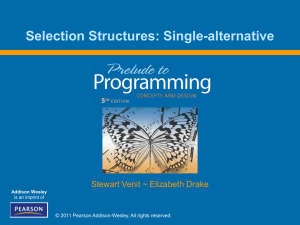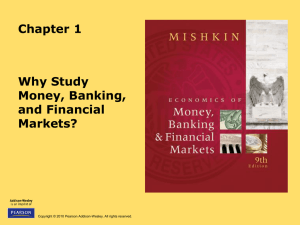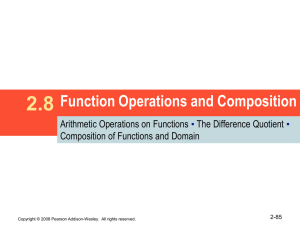
© 2010 Pearson Addison-Wesley
© 2010 Pearson Addison-Wesley
Definition of Economics
All economic questions arise because we want more than
we can get.
Our inability to satisfy all our wants is called scarcity.
Because we face scarcity, we must make choices.
The choices we make depend on the incentives we face.
An incentive is a reward that encourages an action or a
penalty that discourages an action.
© 2010 Pearson Addison-Wesley
Definition of Economics
Economics is the social science that studies the choices
that individuals, businesses, governments, and entire
societies make as they cope with scarcity and the
incentives that influence and reconcile those choices.
Economics divides in to main parts:
Microeconomics
Macroeconomics
© 2010 Pearson Addison-Wesley
Definition of Economics
Microeconomics
Microeconomics is the study of choices that individuals
and businesses make, the way those choices interact in
markets, and the influence of governments.
Macroeconomics
Macroeconomics is the study of the performance of the
national and global economies.
© 2010 Pearson Addison-Wesley
Two Big Economic Questions
Two big questions summarize the scope of economics:
How
do choices end up determining what, how, and for
whom goods and services get produced?
When
do choices made in the pursuit of self-interest
also promote the social interest?
© 2010 Pearson Addison-Wesley
Two Big Economic Questions
What, How, and For Whom?
Goods and services are the objects that people value
and produce to satisfy human wants.
What?
Agriculture accounts for less than 1 percent of total U.S.
production, manufactured goods for 20 percent, and
services for 80 percent.
In China, agriculture accounts for 10 percent of total
production, manufactured goods for 50 percent, and
services for 40 percent.
© 2010 Pearson Addison-Wesley
Two Big Economic Questions
Figure 1.1 shows these
numbers for the United
States and China.
It also shows the
numbers for Brazil.
What determines these
patterns of production?
How do choices end up
determining the quantity
of each item produced in
the United States and
around the world?
© 2010 Pearson Addison-Wesley
Two Big Economic Questions
How?
Goods and services are produced by using productive
resources that economists call factors of production.
Factors of production are grouped into four categories:
Land
Labor
Capital
Entrepreneurship
© 2010 Pearson Addison-Wesley
Two Big Economic Questions
The “gifts of nature” that we use to produce goods and
services are land.
The work time and work effort that people devote to
producing goods and services is labor.
The quality of labor depends on human capital, which is
the knowledge and skill that people obtain from education,
on-the-job training, and work experience.
The tools, instruments, machines, buildings, and other
constructions that businesses use to produce goods and
services are capital.
The human resource that organizes land, labor, and
capital is entrepreneurship.
© 2010 Pearson Addison-Wesley
Two Big Economic Questions
Figure 1.2 shows a
measure of the growth of
human capital in the
United States over the last
century—the percentage
of the population that has
completed different levels
of education.
Economics explains these
trends.
© 2010 Pearson Addison-Wesley
Two Big Economic Questions
For Whom?
Who gets the goods and services depends on the incomes
that people earn.
Land earns rent.
Labor earns wages.
Capital earns interest.
Entrepreneurship earns profit.
© 2010 Pearson Addison-Wesley
Two Big Economic Questions
When is the Pursuit of Self-Interest in the Social
Interest?
Every day, 304 million Americans and 6.7 billion people in
other countries make economic choices that result in
What, How, and For Whom goods and services are
produced.
Do we produce the right things in the right quantities?
Do we use our factors of production in the best way?
Do the goods and services go to those who benefit most
from them?
© 2010 Pearson Addison-Wesley
Two Big Economic Questions
You make choices that are in your self-interest—choices
that you think are best for you.
Choices that are best for society as a whole are said to be
in the social interest.
An outcome is in the social interest if it uses resources
efficiently and distributes goods and services fairly.
The Big Question
Is it possible that when each one of us makes choices that
are in our self-interest, it also turns out that these choices
are also in the social interest?
© 2010 Pearson Addison-Wesley
Two Big Economic Questions
Self-Interest in the Social Interest
Five topics that generate discussion and that illustrate
tension between self-interest and social interest are
Globalization
The information-age economy
Global warming
Natural resource depletion
Economic
© 2010 Pearson Addison-Wesley
instability
The Economic Way of Thinking
Choices and Tradeoffs
The economic way of thinking places scarcity and its
implication, choice, at center stage.
You can think about every choice as a tradeoff—an
exchange—giving up one thing to get something else.
The classic tradeoff is “guns versus butter.”
“Guns” and “butter” stand for any two objects of value.
© 2010 Pearson Addison-Wesley
The Economic Way of Thinking
What, How, and For Whom Tradeoffs
The questions what, how, and for whom become sharper
when we think in terms of tradeoffs.
What Tradeoffs arise when people choose how to spend
their incomes, when governments choose how to spend
their tax revenues, and when businesses choose what to
produce.
© 2010 Pearson Addison-Wesley
The Economic Way of Thinking
How Tradeoffs arise when businesses choose among
alternative production technologies.
For Whom Tradeoffs arise when choices change the
distribution of buying power across individuals.
Government redistribution of income from the rich to the
poor creates the big tradeoff—the tradeoff between
equality and efficiency.
© 2010 Pearson Addison-Wesley
The Economic Way of Thinking
Choices Bring Change
What, how, and for whom goods and services get
produced changes over time and the quality of our
economic lives improve.
But the quality of our economic lives and the rate at which
they improve depends on choices that involve tradeoffs.
We face three tradeoffs between enjoying current
consumption and leisure time and increasing future
production, consumption, and leisure time.
© 2010 Pearson Addison-Wesley
The Economic Way of Thinking
If we save more, we can buy more capital and increase
our production.
If we take less leisure time, we can educate and train
ourselves to become more productive.
If businesses produce less and devote resources to
research and developing new technologies, they can
produce more in the future.
The choices we make in the face of these tradeoffs
determine the pace at which our economic condition
improves.
© 2010 Pearson Addison-Wesley
The Economic Way of Thinking
Opportunity Cost
Thinking about a choice as a tradeoff emphasizes cost as
an opportunity forgone.
The highest-valued alternative that we give up to get
something is the opportunity cost of the activity chosen.
© 2010 Pearson Addison-Wesley
The Economic Way of Thinking
Choosing at the Margin
People make choices at the margin, which means that
they evaluate the consequences of making incremental
changes in the use of their resources.
The benefit from pursuing an incremental increase in an
activity is its marginal benefit.
The opportunity cost of pursuing an incremental increase
in an activity is its marginal cost.
© 2010 Pearson Addison-Wesley
The Economic Way of Thinking
Responding to Incentives
Our choices respond to incentives.
For any activity, if marginal benefit exceeds marginal cost,
people have an incentive to do more of that activity.
If marginal cost exceeds marginal benefit, people have an
incentive to do less of that activity.
Incentives are also the key to reconciling self-interest and
the social interest.
© 2010 Pearson Addison-Wesley
The Economic Way of Thinking
Human Nature, Incentives, and Institutions
Economists take human nature as given and view people
as acting in their self-interest.
Self-interested actions are not necessarily selfish actions.
But if human nature is given and people pursue selfinterest, how can the social interest be served?
Economists answer by emphasizing the role of institutions
in creating incentives to behave in the social interest.
Paramount: the rule of law that protects private property
and facilitates voluntary exchange in markets.
© 2010 Pearson Addison-Wesley
Economics: A Social Science and
Policy Tool
Economics as Social Science
Economists distinguish between two types of statement:
What is—positive statements
What ought to be—normative statements
A positive statement can be tested by checking it against
facts.
A normative statement cannot be tested.
© 2010 Pearson Addison-Wesley
Economics: A Social Science and
Policy Tool
Unscrambling Cause and Effect
The task of economic science is to discover positive
statements that are consistent with what we observe in the
world and that enable us to understand how the economic
world works.
Economists create and test economic models.
An economic model is a description of some aspect of
the economic world that includes only those features that
are needed for the purpose at hand.
© 2010 Pearson Addison-Wesley
Economics: A Social Science and
Policy Tool
A model is tested by comparing its predictions with the
facts.
But testing an economic model is difficult, so economists
also use
Natural experiments
Statistical investigations
Economic experiments
© 2010 Pearson Addison-Wesley
Economics: A Social Science and
Policy Tool
Economics as Policy Tool
Economics is a way of approaching problems in all
aspects of our lives. Three broad areas are
Personal economic policy
Business economic policy
Government economic policy
© 2010 Pearson Addison-Wesley








